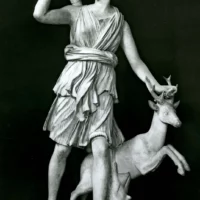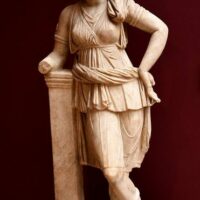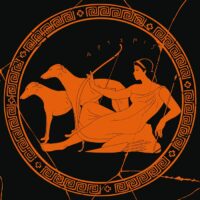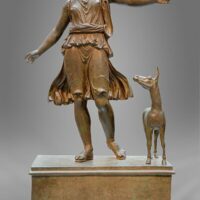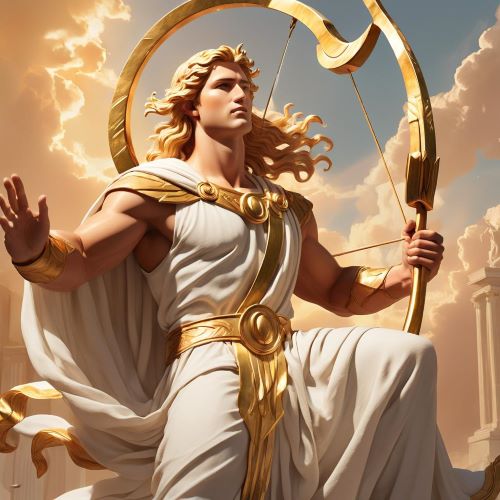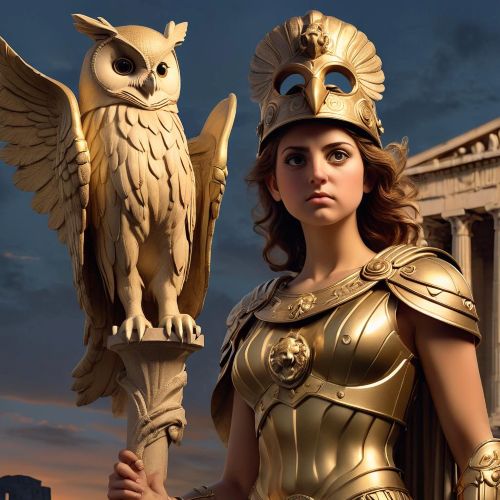Artemis : Goddess of the Hunt
Listen
At a glance
| Description | |
|---|---|
| Origin | Greek Mythology |
| Classification | Gods |
| Family Members | Zeus (Father), Leto (Mother), Apollo (Brother), Athena, Hermes, Dionysus, Persephone, Ares, Hephaestus (Half Siblings) |
| Region | Greek |
| Associated With | Hunt, Moon |
Artemis
Introduction
Artemis, one of the most enduring deities of Greek mythology, occupies a unique position among the Olympian gods. She is revered as the goddess of the hunt, wilderness, wild animals, vegetation, childbirth, and chastity. Often associated with the moon, she represents both the untamed power of nature and the protection of innocence. The daughter of Zeus and Leto and twin sister of Apollo, Artemis embodies independence and purity, standing apart from the domestic roles expected of women in ancient Greece. Unlike many Olympians, her worship was widespread across regions, with local traditions highlighting different aspects of her divinity. In every form, however, Artemis symbolized strength, autonomy, and the vital cycles of life and death.
Physical Traits
In classical art and literature, Artemis is consistently portrayed as a maiden goddess with an athletic, youthful body, emphasizing her eternal virginity and vitality. She is most often depicted with a short chiton that allowed freedom of movement while hunting, a quiver of arrows at her back, and a bow always ready at hand. A stag or hunting dogs usually accompany her, reinforcing her role as the protector of wild creatures. Ancient poets described her as tall, radiant, and fleet-footed, with a beauty that was striking yet severe, unadorned by the embellishments of goddesses like Aphrodite. Some depictions show her wearing a crescent moon diadem, linking her closely with lunar cycles. Unlike most Olympians who were celebrated for their opulence, Artemis was remembered for her simplicity and agility, a reflection of her close bond with the wilderness.
Family
Artemis was born to Zeus, the king of the gods, and Leto, a Titaness who endured Hera’s relentless persecution during her pregnancy. According to myth, Hera forbade any land from sheltering Leto, forcing her to wander until she found refuge on the floating island of Delos. There, Artemis was born first and soon after helped her mother deliver Apollo, her twin brother. This mythic moment established her role as a goddess who presided over childbirth, despite her vow of virginity. Though she had many half-siblings through Zeus, Artemis’s closest divine connection was always with Apollo, with whom she shared domains of archery, prophecy, and celestial bodies—the moon for Artemis and the sun for Apollo. Some local myths presented alternate parentage, but the dominant tradition always tied her identity to Zeus and Leto.
Other names
Artemis was venerated under countless names and epithets across the Greek world, reflecting the breadth of her divine functions. The Romans equated her with Diana, but the Greek tradition preserved more specific titles. As Potnia Theron, or “Mistress of Animals,” she was invoked as guardian of wild creatures. In Attica, she was worshipped as Brauronia, where young girls took part in rituals that symbolized the transition to womanhood under her care. In Sparta, she was called Orthia, a name tied to ancient rites of endurance. The epithet Agrotera, meaning “of the wilds,” highlighted her hunting aspect, while Prothyraia referred to her role in aiding women in labor. These varied names underscore her adaptability in different local cults, where Artemis could be invoked as a huntress, a protector of youth, a lunar goddess, or even a bringer of vengeance.
Powers and Abilities
Artemis wielded immense powers that reflected her domains. Her archery skills were unrivaled, and her arrows could both kill swiftly and inflict disease, particularly upon women and children, balancing Apollo’s dominion over men. Despite her deadly capabilities, she was also invoked as a healing goddess who could relieve suffering and protect the vulnerable. Artemis presided over childbirth, deciding fates in moments of peril, and offered her care to young girls until they reached maturity. She was also a fierce defender of her chastity and boundaries, punishing any mortal who disrespected her sanctity. Notable myths illustrate her merciless justice: she transformed Actaeon into a stag when he spied upon her bathing, sent the monstrous Calydonian Boar to punish a king who neglected her, and played a decisive role in the story of Iphigenia, where she demanded a sacrifice before the Greek fleet could sail to Troy. Her powers extended beyond archery and punishment—she could shapeshift, command animals, and even manipulate natural forces, making her one of the most versatile Olympians.
Modern Day Influence
Artemis’s legacy continues to resonate in contemporary society, where she is frequently reinterpreted as a symbol of female empowerment and independence. Her image as a self-sufficient huntress and protector of the innocent has made her an icon in feminist movements and modern retellings of mythology. Literature and media often adapt her archetype into characters who embody autonomy, resilience, and a deep connection to nature. In science and technology, her name carries symbolic weight: NASA’s Artemis program, for example, is dedicated to returning humans to the Moon, with the name reflecting her lunar associations and pioneering spirit. Beyond space exploration, her name is used in medicine, architecture, and environmental initiatives, underscoring her relevance as a goddess tied to cycles of life, health, and the natural world. Through these modern reinterpretations, Artemis continues to inspire humanity’s pursuit of knowledge, balance, and respect for nature’s untamed power.
Related Images
Source
Greek Mythology Worldwide. (2024, September 21). The impact of Artemis on modern literature and pop culture. Retrieved from https://greek.mythologyworldwide.com/the-impact-of-artemis-on-modern-literature-and-pop-culture
Ancient Literature. (2022, January 11). Artemis’ personality, character traits, strengths and weaknesses. Retrieved from https://ancient-literature.com/artemis-personality
GreekMyths-GreekMythology.com. (n.d.). Artemis: Goddess of the hunt, wilderness, and the moon. Retrieved from https://www.greekmyths-greekmythology.com/artemis-goddess
Lloyd-Jones, H. (1983). Artemis and Iphigeneia. The Journal of Hellenic Studies. https://www.cambridge.org/core/journals/journal-of-hellenic-studies/article/artemis-and-iphigeneia/6EEC3E026212A5599D0991827AF58D22
Contributors to Wikimedia projects. (n.d.). Artemis – Wikipedia. https://en.wikipedia.org/wiki/Artemis
Artemis | Myths, Symbols, & Meaning – Britannica. (2025). https://www.britannica.com/topic/Artemis-Greek-goddess
Frequently Asked Questions
What is lorem Ipsum?
I am text block. Click edit button to change this text. Lorem ipsum dolor sit amet, consectetur adipiscing elit. Ut elit tellus, luctus nec ullamcorper mattis, pulvinar dapibus leo.
What is lorem Ipsum?
I am text block. Click edit button to change this text. Lorem ipsum dolor sit amet, consectetur adipiscing elit. Ut elit tellus, luctus nec ullamcorper mattis, pulvinar dapibus leo.
What is lorem Ipsum?
I am text block. Click edit button to change this text. Lorem ipsum dolor sit amet, consectetur adipiscing elit. Ut elit tellus, luctus nec ullamcorper mattis, pulvinar dapibus leo.
What is lorem Ipsum?
I am text block. Click edit button to change this text. Lorem ipsum dolor sit amet, consectetur adipiscing elit. Ut elit tellus, luctus nec ullamcorper mattis, pulvinar dapibus leo.
What is lorem Ipsum?
I am text block. Click edit button to change this text. Lorem ipsum dolor sit amet, consectetur adipiscing elit. Ut elit tellus, luctus nec ullamcorper mattis, pulvinar dapibus leo.




